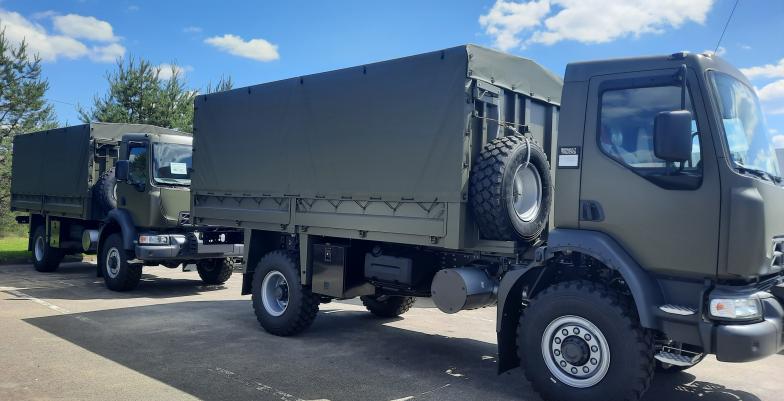A Security and Defence approach fit for the future
European Peace Facility (EPF)
In an era of strategic competition and global security threats, the European Peace Facility (EPF) expands the EU’s ability to provide security for its citizens and its partners. Since 2021 the EPF serves as a unified financing mechanism for the EU’s military and defence actions, with Member States contributing to the fund in addition to their contributions to the general EU Budget.
The operations pillar of the EPF funds the common costs of military missions and operations under the Common Security and Defence Policy (CSDP), contributing to the EU’s ability to serve as a global security provider.
Under its assistance measures pillar, the EPF finances support under the Common Foreign and Security Policy (CFSP) to strengthen the capacities of third states and regional organisations to enable them to better face threats to local, regional and international security.
When providing military equipment and support to third states, the European External Action Service (EEAS) carefully monitors partners’ compliance with Council decisions, international human rights law, international humanitarian law and all relevant arms export laws.
Navigate the topic
Added value of the EPF
Closing gaps in the EU’s existing toolbox by enabling “train and equip” assistance measures, easier burden sharing for joint EU military missions and flexible responses to developing crises, the EPF enables Europe to do more and to act more swiftly by maximising the impact, effectiveness and sustainability of overall EU external action in peace and security.
Targeted Assistance
Enabling EU assistance to third countries following the principle of “equip & train”, the EPF allows for more effective capacity building through the use of assistance measures to equip partners with the tools they need to best make use of EU training missions. This will allow the EU to further improve the capacities of partners to address crises, prevent conflicts and look after their own security needs – thus increasing security and stability for both their populations and EU citizens.
Easier Financing
The EPF can be used to fund military exercises, enhancing further the EU’s readiness to respond to external conflicts and crises and enabling the EU to better support partners on a global level. It also covers an increased range of the common costs of missions and operations, making it easier for Member States to commit to operations under the CSDP.
Flexible Funding
Initially set up with a value of EUR 5 billion for a seven-year period, the EU has increased funding for the EPF to EUR 12 billion to enable effective support for Ukraine in its fight against Russia’s war of aggression as well as further support to global partners. As an off-budget funding mechanism, separate from the EU’s multiannual financial framework, the flexibility of the EPF will ensure that EU funding is available for both long-term support to EU partners and effective crisis response in quickly developing situations.
The Operations Pillar
EU Missions and Operations funded by the EPF
In general, the principle of 'costs lie where they fall' applies to the financing of military operations and missions under the EU’s Common Security and Defence Policy. This means that costs, including expenditures for equipment and personnel, are borne by the participating Member States.
These common costs include the running costs of mission headquarters and their transport to and from the theatre of operations, costs of medical services and facilities for the mission as a whole, as well as costs to improve infrastructure needed to fulfil the mission (airports, harbours, roads, storage and sanitation facilities).
As Article 41(2) of the Treaty on European Union prohibits charging costs arising from operations with military or defence implications to the Union’s budget, these expenses are covered by the off-budget European Peace Facility.
To learn more about the ways the EU is working for a stable world and a safer Europe, follow the link to the page about CSDP Missions and Operations.
Rapid Deployment and Exercises
The EPF also funds joint military exercises, in line with the priorities of the Strategic Compass for Security and Defence approved by the Council in March 2022. For missions making use of the EU’s Battlegroups, the EPF can also provide additional funding for the rapid deployment of Battlegroups via land, sea or air, as well as for their initial provision with supplies.
Financial support for EU missions and operations under the EPF is managed by an Administrator for Operations within the Council General Secretariat.
When it comes to military operations and CSDP missions, in general, costs such as expenditures for equipment and personnel, are borne by the participating Member States.

European Union
The Assistance Measures Pillar
Assistance Measures funded by the EPF
The EPF supports beneficiary countries to strengthen the capabilities of their armed forces. Since the establishment of the EPF in 2021, assistance measures have been adopted in support of partners in Africa, the Western Balkans, the Middle East and the Eastern Neighbourhood of the EU as well as for regional international organisations engaged in peace support missions.
Assistance measures through the EPF can take a variety of forms depending on what support has been requested by a partner country. Assistance ranges from the delivery of military equipment to the provision of aerial surveillance as a service and financial support to improve military infrastructure.
Most assistance measures deliver non-lethal military equipment, including personal protective equipment for individual soldiers, medical equipment and field hospitals, engineering and demining equipment, cyber-defence equipment, as well as vehicles and boats.
In some cases, the Council has decided to provide equipment designed to deliver lethal force through the EPF.
Implementation of assistance measures under the EPF is coordinated by the Commission’s Service for Foreign Policy Instruments as Administrator for Assistance Measures.

European Union
EU Support to Ukraine enabled by the EPF
In response to Russia’s war of aggression, the EU has provided unprecedented political, humanitarian, financial and military support to Ukraine. Overall assistance for Ukraine by the EU and Member States amounts to more than €82 billion, including €28 billion in military support.
The EPF has been an important instrument of sustained EU support for Ukraine’s defence: leveraging more than €6 billion in funding through the EPF for incentives for joint procurement and reimbursements for Member States’ deliveries as well as for the EU Military Assistance Mission to Ukraine has enabled the EU and Member States to provide equipment and other support valued at over €14 billion to the Ukrainian armed forces.
Learn more about other ways the EU stands with Ukraine by visiting the page outlining the EU’s support to Ukraine.
EU Military Assistance Mission in support of Ukraine
The EU Military Assistance Mission (EUMAM) was established by the Council in October 2022 to strengthen the capacity of the Ukrainian Armed Forces to defend Ukraine’s territorial integrity and to coordinate Member States’ training activities in support of Ukraine.
As part of the mission, 24 EU Member States provide training to members of the Ukrainian Armed Forces, with more than 40 000 Ukrainian Soldiers trained until early 2023.
The EPF supports the mission by funding the common costs of the training, including translation services, food and transportation for Ukrainian soldiers training in EU Member States, and also providing funding for lethal and non-lethal equipment supplied to the trained Ukrainian units.
EU Ammunition Initiative
On 20 March 2023, the Council decided to implement a three-track proposal put forward by the High Representative and the Commission to urgently provide Ukraine with artillery ammunition.
The EPF supports the EU’s commitment to Ukraine’s defence by providing funding of up to EUR 2 billion for the delivery of artillery ammunition and missiles to the Ukrainian Armed Forces, both from the existing stocks of Member States (Track One) and through the joint procurement of new ammunition (Track Two).
Additionally, the Commission adopted the Act in Support of Ammunition Production (ASAP) on 3 May 2023 as a third track aimed at ramping up the EU’s production capacity for ammunition and missiles.
Military Equipment provided by EU Member States
The EPF also provides support for the delivery of lethal and non-lethal military equipment to the Ukrainian Armed Forces not related to the work of the Military Assistance Mission or the Ammunition Initiative.
From February 2022 to February 2023, the Council adopted 7 military support packages for Ukraine, together including over EUR 3.6 billion in funding from the EPF. This support includes the reimbursement of Member States for equipment delivered from their national stockpiles starting from February 2022.







